#unflattering self portrait
Text
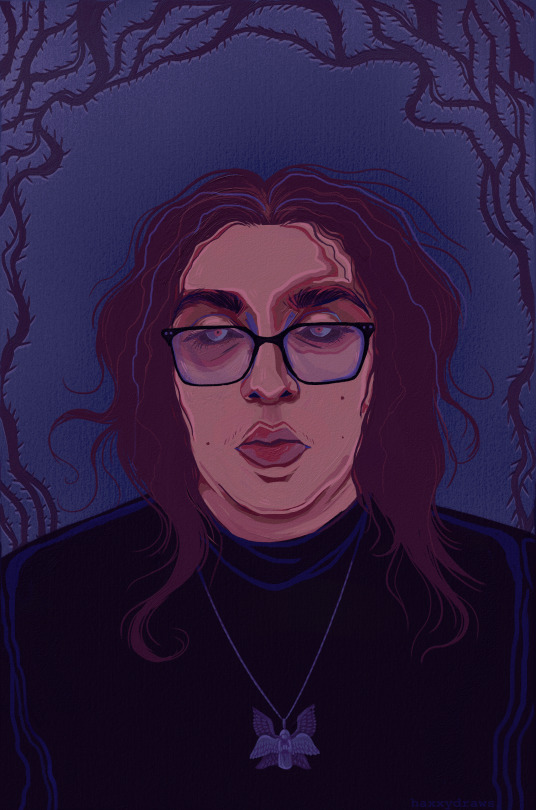
thorns
#self portrait#all of my self portraits are very red so i wanted to do a blue one#painted#2023#when in doubt take an unflattering selfie and paint over it#also i didn't cut my hair this is just the way that it slowly falls out of my ponytail over time sjdkfl
30 notes
·
View notes
Text
This is my Patreon! I figured I may as well post about it despite only having like, a single follower.
I'm a composer, and I am currently writing a musical. This is not some tall tale that will never come to pass; it is a reality that is being workshopped in two months, and hopefully premiered this time next year! In the meantime, I'd like to build up a group of like minded theatre folks who'd like to follow the creative process of the making of a musical from its very beginnings.
This Patreon supports me as the writer and composer, not the show itself. That will come later, when we get closer to the actual production- and that will depend on my having found that group of like minded theatre folks I mentioned.
I'm all about accessibility in theatre. I am one of those folks who is always on about making proshots available for every show, for all the folks who can't afford broadway ticket prices. With your support, I can make certain that my show, and all my future shows, are accessible to all who want to see them.
So, if you can spare a few bucks a month, I'd appreciate your support. Check out my Patreon to see all the perks that come with each tier.
If you're on the fence, maybe click that follow button in the meantime, and stay tuned. I won't post content from the musical here nearly as often as I do on Patreon, but I'll let a few things come through to intrigue anyone willing to lend me a moment of their time.
Thanks for considering.
#patreon#my patreon#musical theatre#musical theater#broadway#broadway musicals#theatre kid#theater kid#self promo#self promotion#idk what all I should tag this with#music#and yes#by the way#i will always make sure that my portrait is a ridiculous and unflattering photo#that's more fun than pretty
7 notes
·
View notes
Text

it was my transiversary today :)
#doodle#wish i couldve done like a reflection comic or something#but this was the best i could do i am very tired lol#this self portrait is very unflattering but i enjoy it#the icecream cake i got was really good also :) super cold though#like colder than normal icecream somehow
6 notes
·
View notes
Text
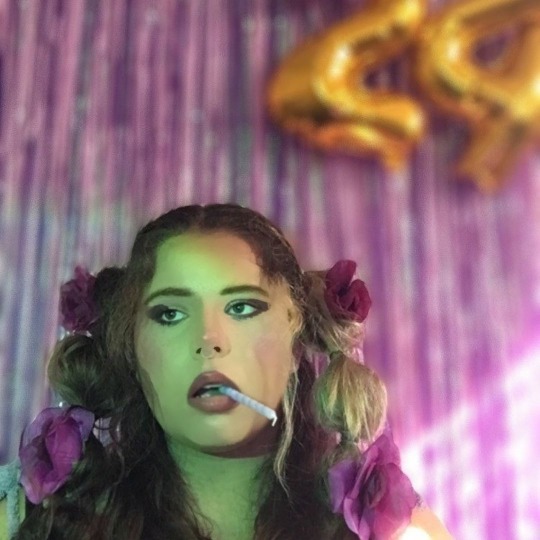




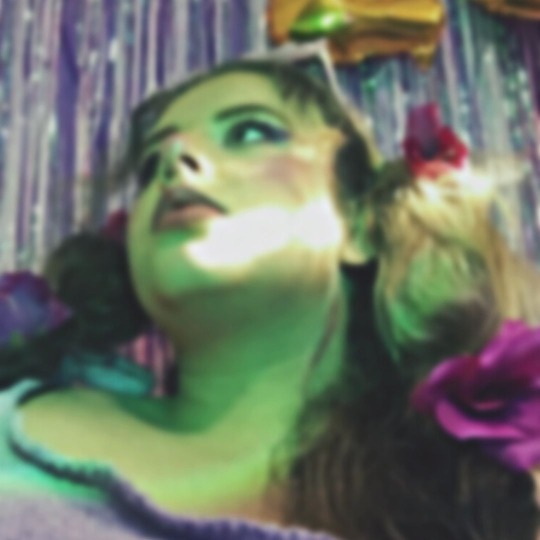

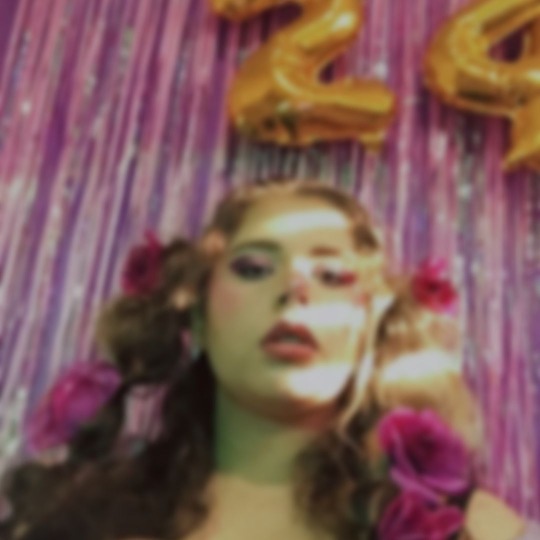


Sometimes you just have to hang up a cheap table cloth and cheap birthday decorations to take photos no one cares to see or not see
#it was my birthday#feb 12 2023#self portrait#plus size#unflattering angles#but I still look good#birthday#photografy#self photography#self photoshoot
1 note
·
View note
Text
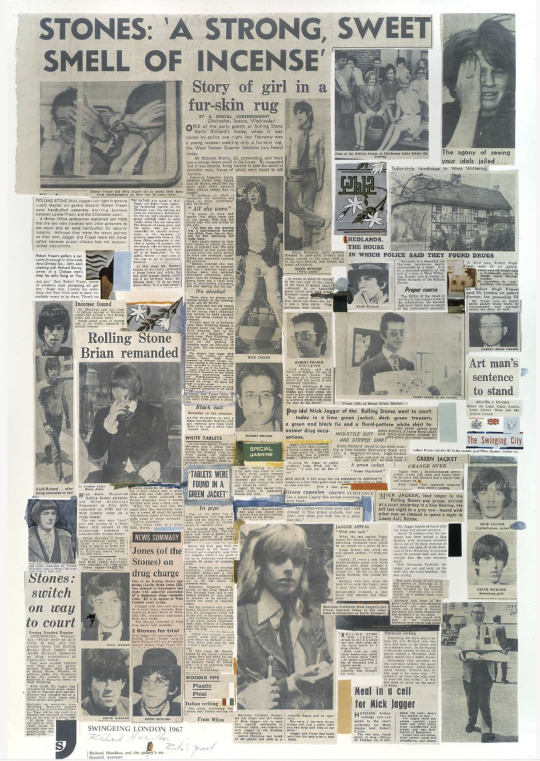

Richard Hamilton Swingeing London 67 poster and Beatles 68 poster
Text from Andrew Wilson's Swingeing London 67
The [Beatles] poster, described by Hamilton as a 'give-away' print, was the result of a fairly complex design process that took about two weeks to complete, with daily visits from Paul McCartney, the one Beatle who worked directly with Hamilton on the project and who had prior knowledge, through[Robert] Fraser, of Hamilton's work--he had earlier bought one of the Solomon R. Guggenheim (1965) screenprints from the 1966 exhibition of the series that he had helped hang.
This relationship gave Hamilton the freedom to develop his idea for the poster and the whole design project without interference from the other band members, Yoko Ono, or the record company.
The poster shows George Harrison, John Lennon, McCartney and Ringo Starr as distinct individuals. This is in sharp contrast to the individual John Kelly portraits, in which the similarities of pose, gaze, and lighting, conforming to the aesthetics of of a record company's publicity department, portray them as members of a band.
The seemingly casual pinboard aesthetic by which these informal photographs were arranged was determined primarily as a solution to crucial design issues (echoing his decision to order the collage for Swingeing London 67--poster as newspaper columns, with headline at top left).
The sheet had to be folded three times in order to be inserted into the square album sleeve, and this obliged Hamilton to approach it as 'a series of subsidiary compositions. The top right and left-hand square are front and back of the folder and and had to independently stand as well as be a double spread together. The bottom four squares can be read independently and as a group of four. They all mate together when opened up and used as wall decoration.'
The top left-hand panel is what is seen first, and it presents the songwriting duo of Lennon and McCartney. Lennon is shown in blue light, singing. The image has probably been taken from a television screen, and the attendant distortion and blue glow are unflattering.
The image of Lennon overlays the bottom right corner of an equally unusual portrait of McCartney in a bathtub, his head half submerged, soapy suds giving him a halo. Running beneath the two portraits is a fabricated contact strip that includes an image of Lennon in front of one of his wall drawings; the band in a recording session...in which they are, unusually, playing brass instruments; and a colour image from the recording of 'Hey Jude' (1968).
This sense of fragmentation, of hidden codes and messages, echoes both the 'guarded privacy and locked rooms' and the 'disturbing, dreamlike darkness' that have been identified in the album, inviting the fan to imagine the band members' private worlds, and hinting at the beginning of the band's disintegration.
The dominant image of the poster's top right panel, opposite Lennon and McCartney, is of George Harrison. This portrait casts him in a mystical, otherworldly and contemplative light, with the right side of his face obscured and out of focus....
There are very few collective photographs of the band: playing in recording sessions or in filmed concerts; with Harold Wilson after they had each received the MBE; and a sequence of them doing the 'business' as they re-sign their contract with EMI.
Instead, the poster emphasizes the individual activities of John, Paul, George and Ringo around the time of the collage. Starr is shown with his co-star from the film Candy (1968), Ewa Aulin, and also dancing with Liz Taylor (wife of his other co-star in the film, Richard Burton). Lennon is shown becoming the working-class hero. Yoko Ono appears just twice: in a self-portrait by Lennon of the naked couple, and in an image of a naked Lennon sitting cross-legged in bed talking on the phone, as its stretched cord cuts her out-of-focus head in two--cancelling her identity.
Of the band, it is McCartney who emerges as the poster's dominant figure. Hamilton has said how The Beatles contains 'arcane touches which only The Beatles' more intimate associates were likely to smile at,' and yet such details--such as the doubled image of a shut door or McCartney 'pole dancing' both naked and clothed--are not at the cost of the poster's legibility. At its centre is the reverse of a photograph, a gift to one of the band, bearing a lipstick imprint and a groupie's imploring words: 'I love you.'
In all this, Hamilton's fundamental aim for The Beatles was that it should reach a large audience and be as accessible as the cover design was remote. This was not a new subject for Hamilton. My Marilyn had already adopted, three years earlier, the motif of the publicity photograph and the manipulation of celebrity image as a subject. What is different here is Hamilton's direct participation in popular culture: The Beatles, like Swingeing London 67--poster, shows him not only constructing work with a subject that revolves around the manipulation and production of pop celebrity imagery, but also inserting these works into the mass circulation of popular culture.
--Andrew Wilson. Bold mine.
#the beatles#richard hamilton#robert fraser#Really interesting read of The White Album poster#'arcane touches which only the Beatles' more intimate associates were likely to smile at'?#The phone cord 'cancelling [Yoko's] identity?#Really great to have this context for Hamilton's work too
88 notes
·
View notes
Text
i draw self portraits and portraits of other people sometimes and every time it surprises me when someone is shocked or appalled if i draw “unflattering” traits like moles or scars. i’ll get asked “why did you draw your acne? you could’ve left it out” and i just want to grab their shoulders and give them a good shake to get the idea out of their head that i should leave parts of myself behind. it’s a Self Portrait. im drawing myself, not some sanitized version of myself that holds barely any semblance. why wouldn’t i draw my face as it is? what is so bad about looking human? why should i feel ashamed of something i can’t control? i draw my acne because i have acne. i drew that mole because i have a mole. so what? i want to feel comfortable in my own skin, i want to embrace the imperfections and the blemishes because i think there’s beauty in them, because they’re part of me and i love them. im not gonna pretend i don’t have them because someone decided they were gross or off-putting. people are works of art and it would be a shame not to express that beauty in its many forms
266 notes
·
View notes
Note
any awkard date stories?
I have no intention of sharing unflattering personal stories with a complete stranger in this unagnidly place.
Although, I'm in a benevolent mood today, so I agree to answer just because I have spent the last fourteen hours staring at a wall and I am beginning to doubt reality itself. And I have a slight suspicion that Zuko is putting cactus juice in my soup. I will not give him the satisfaction of going senile. It's enough with Iroh.
As a Prince of the Fire Nation, I always had less free time than an ordinary young man. My time had to be carefully invested in improving my skills and knowledge to better fulfill my role as a Prince. Therefore I never had much time to court women (unlike Iroh). But it never really mattered to me since, let's be honest, I was absolutely superior to any of my potential dates.
So I never went on many dates, let alone embarrassing ones. The few dates I had with Michi went pretty well. She cannot burn down villages but you should see what she can do with a hammer.
But there was a period of time before I married Ursa when I had to court her according to our traditions. And Agni, there were many embarrassing moments there. It was very difficult to turn the peasant girl into a Princess.
1) On our first date, she mistook the hand washing water in the finger bowl for a soup.
2) Once she was so nervous that she called my father "Furrylord".
3) She accidentally knocked out the bard on our second date.
4) She sneezed on my mother's portrait. My father almost incinerated her.
5) She spilled hot soup on Iroh's pants.
6) She said Zhao looked like a monkey with those sideburns. Zhao was behind her.
7) She spilled hot tea on Iroh's pants.
8) She tried to compliment our 'collection of mummies'. It was Lo and Li standing in a corner.
9) She spilled hot chocolate on Iroh's pants. There is a reason why Lu Ten did not have siblings.
My wife Ursa was totally different from all the women I had known. She was a clumsy, vulgar peasant girl with a raucous laugh and the self-preservation instincts of a three-year-old (Zuko must have inherited it from her). My father was on the verge of returning her home (or strangling her) at least six times, but in the end he always remembered how much he wanted those powerful grandchildren to serve Lu Ten.
Back then Ursa filled me with importance and constantly tested my patience, but now I realize those were our best days.
#There was also the time in which she accidentally poisoned Iroh#Iroh always assumes everything is tea#ask ozai#urzai#Ozai#Ursa#Iroh#Azulon#Michi#Lo#Li#Zhao#Atla#avatar the last airbender
64 notes
·
View notes
Text
the thing is the thing is the thing is--
i know i am not a good person. ask me, i will tell you.
but it is still so very jarring to have your own ugliness reflected back at you from someone/where else, you know? like being forced to stare into a still pond after avoiding mirrors your whole life.
i don't want to see it. don't want to be reminded of that part of me i keep so carefully tucked away as much as possible. (i am weak and sometimes it slips out and I'M SORRY i'm trying but i cannot rip it out at the root though i have attempted the procedure.)
and i can recognize this grotesqueness so easily in myself and others. can empathize with it even as i stamp my feet and promise i would never - I WOULD NEVER.
but i would and i know it and that fact is inescapable no matter how often or fervently i lie to myself about it.
it's like an unflattering self-portrait has taken on its own life, gripped my face in an ink-stained grasp and screamed LOOK AT ALL YOU ARE AND WILL EVER BE GAZE INTO THE DEPTHS OF ALL YOU HAVE BECOME THROUGH INARTICULATE COMPLACENCY WITH YOUR HISTORY.
easier to stew than to uproot a tree. to simmer in the what is without facing its repercussion. without taking responsibility for the ugly twisted thing that bloomed in its wake (me).
no amount of apologizing can undo a misdeed. the quality of self-reflection does not--can NEVER--erase the mistakes of the fragile, the injured. the ego that cannot let go of the snare which broke it. the only answer to cruelty is the pain of another.
sometimes it feels meaningless to even try (i know it isn't but i cannot let go of the guilt).
8 notes
·
View notes
Text
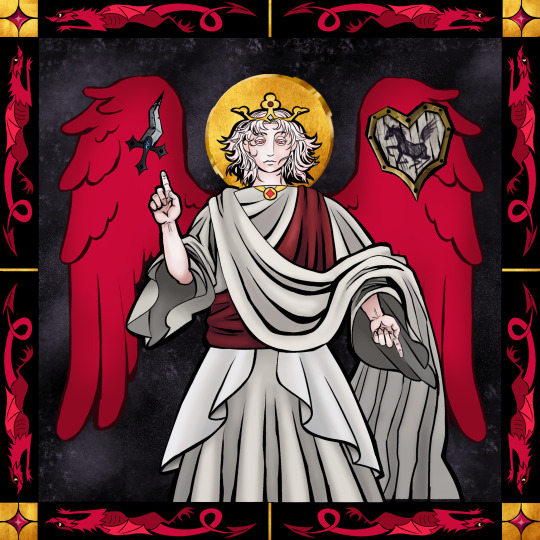
Sanguine Wyrmsbane
there are plenty of paintings and stained glass portraits of historical and mythological figures to be found in the chapel and castle but chief among them are depictions of sanguine, the first emperor, deified while he was alive. obviously, the sun doesnt shine on the capitol of the western empire anymore, it hasnt for centuries, so these stained-glass pieces dont glow like theyre supposed to, but that hasnt stopped artisans from continuing to make them. the hope is that one day the sun will come again and shine on the empire and its people once more, when the east has been defeated and the last of the dragons have been vanquished and the curse has been lifted.
finally finished this aka lost motivation and stopped. i meant to make it more visibly stained-glass-looking but. yeah. lore
featuring an unflattering depiction of rubellum from likely several hundred years after she was captured and locked away. at this point her memory has become sort of just a piece of mythology. the people still believe that sanguine vanquished her but they dont know anything after that, including what she even looks like, and that's intentional on sangy's part. he is obsessed with immortalizing himself and his life in the most self-aggrandizing way possible
4 notes
·
View notes
Text

Some guy at an event today looked at this self portrait in the back of my latest book and told me it was "unflattering" and that I should draw myself to look better, fully intending it to be a compliment
Anyway draw yourself more masc and gross out men kis kis
#he also dissed the bio in the back of the book#why are men like this#sir i am happily married and will draw myself how i please#self portrait#ell art#oh yeah he also called it a selfie lmao
8 notes
·
View notes
Text
to celebrate senior year and approaching 500 followers i have upgraded my icon to an even funnier more unflattering self portrait. enjoy
5 notes
·
View notes
Note
How common are biographical works in the underground in general?, we know a cetain Ice King got very 🗡️(or is it 💉)? Over some negativety, but I would presume it happens?
(continued) On samsids answer: how about a biopics of dead controversial figure like Cannon, beyond being unpopular, ( or irrelevant like Ozark( I Presume)? Or Belmonts dad ofc)
Are they considered gauche?
Do people just not in general make media about current/ living figures often? I imagine a revolution with the downfall of an unpopular king would be a subject that the East at least would engage with a lot.
Did I understand that right about troy? Like even if someone writes a book about how much he sucks? Or us it would enemy in specific just be alright as that means he is dangerous or similar? Or if he is just a dick(though accurate, but idk if he strikes me as a guy with self awareness on that lvl)Or in a Ohhhh ME! Kinda way
---
My answer got long, so I'm gonna put it under a cut.
So, we know the underground is a pretty lawless place where the threat of revenge and retaliation from powerful people is the primary form of order and enforcement. It'd take a lot of guts for an independent author to embarrass a powerful underground figure. The only sphere where people can really get away with it is the South, with its attitude of "attack one of us and you attack all of us." (Hence their top tier journalism.) If the South wrote a book about some random North Sphere asshole, all the asshole's enemies would be celebrating the book while everyone else dismissed it as yet more South Sphere slander.
Unpopular isn't always the opposite of powerful. Cannon was super unpopular among the East Sphere militias and aces, but attitudes in the sphere's official military and across the sphere were more split. (Book 3 of Merritt's Story, and later in DOTU, is where we'll go in depth on this...) A lot of armbands *loved* his brutality - not a majority of armbands, but enough to be dangerous. They loved that he dealt with a disobedient explosives unit by blowing up everyone in the unit but one. And he was a King - he was powerful and had powerful allies. It'd actually still be risky to slander him. Aaaaand even if you don't care about Cannon, if you're an enemy of his enemy, you still have an incentive to wreak havoc on his behalf. (For example, it would be SUPER risky to be the new King, or the person who killed Cannon, and to reveal a vulnerability that can be exploited by Cannon's old allies... but that's another matter.)
The West Sphere can get away with a little more in movies and TV, because their industry does have a lot of power. But they still don't want to step on too many landmines. Also, biopics aren't quite as popular and lucrative as Killer Cucumber and the like.
As for Troy, we probably shouldn't assume he read the entire book instead of just admiring his own portrait on the cover. XD
For real, though, Troy isn't as sensitive to general badmouthing as one might think. For him, it really depends on *who* is doing the badmouthing, to what audience, and what's being said. If he doesn't respect the writer and doesn't care whether the writer respects him, it's not worth his time. He's used to the East's abusive language and actually has a pretty thick skin in some regards. It's only a few specific people who can really get under it...
Oh, and about Belmont's dad - He became irrelevant enough that it's pretty safe to write an unflattering biography on him these days. But I'm sure there's already one out there by a certain multitalented author... ;)
2 notes
·
View notes
Text
Week 5_ WIP > Self portraits

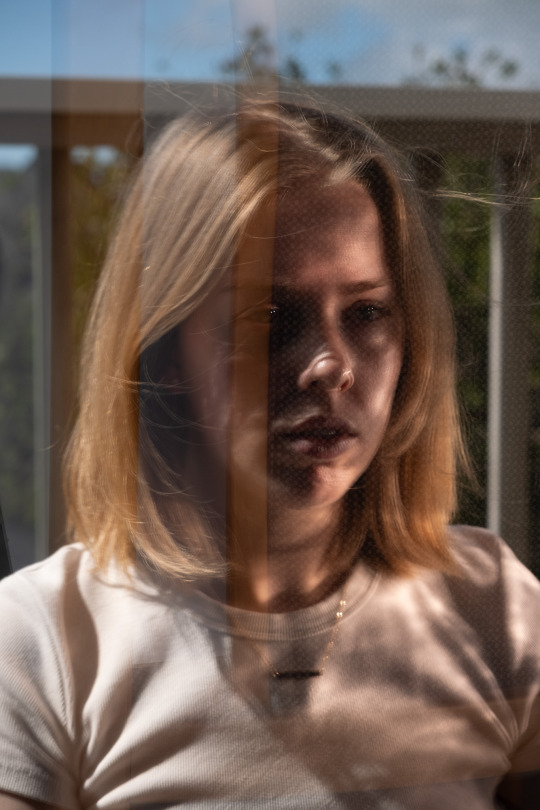





WIP Commentary:
What's working?
The closer-up shots - definitely - I have discovered that in most cases AF is better used that MF (with the exception of super close up shots) and I now also know how to meter properly so I can use AF correctly rather than just hoping it'll get the right spot.
The experimentation with different lighting set ups. All of these shots used natural, ambient or available light - I am yet to take any successful shots with created light which I would definitely like to do. However, I like the ambient light for how soft it is. Reflecting now on the indoor shots in the lot above - I think improvement could be achieved with using a reflector to get greater depth and contrast in the same lighting situations. As some of them are still quite flat, especially with highlights.
What did I want to portray?
To be honest I didn't necessarily contemplate this too much before taking the images but I think I want to portray myself in a more serious fashion than I think a lot of people see me in daily life. I come across very bubbly and joyful a lot of the time but as an introvert with very limited social energy this is my expression for the most part. People tend to comment when I'm not smiling as much or am not as chirpy that I look upset or angry or think something is wrong (I've been told this for years and years) so I have grown conscious of what my face looks like when its resting. So in a way this is my own - personal - reframing what I look like with a serious expression/expressionless.
Alongside this - just simplicity - I didn't want anything to grand or complex in these images as that doesn't match my personality. I think the use of the black and white represents a subtle boldness and simplicity that doesn't distract from the subject.
Personal experience / contemplation of self:
I don't have the fondest relationship with the camera - in terms of capturing myself. I'm not very confident capturing myself - I don't think I ever have been. This is one of the reasons why my selection here capture me without much expression. My key image at the moment (the first one) is probably the most vulnerable and intimate shot I've taken of myself.
Just like most I'm not super comfortable with my face - the placement of my hand in this image was for that very reason and kind of places that insecurity in the image as I'm hiding it . One of my biggest insecurities is my mouth/chin area. It stems from so many pictures that I've been in where someone captures me with a big gummy smile or from a really unflattering angle emphasising my chin/neck. There are very few occasions where I like how I'm portrayed in images other's take of me.
Also taking these pictures at home added an extra vulnerability. I became more and more comfortable taking photos but didn't feel like I could fully capture myself - maybe how I wanted - because I had/have other family members at home some days. I think to give myself the space to express myself more - using the photo studios as a self-portrait space and to have the security of no one else being around might help. Also taking any chances of having the house to myself and giving myself space to feel more comfortable infront of the camera would help.
The use of black and white in my edits was both an aesthetic choice as well as a personal one. Apart from the two images above where I quite liked the colouring of my skin and hair, the others (also the fact that they were framed tighter) were closer and I didn't feel comfortable with certain elements of my skin being in colour for example.
0 notes
Text
Week 10: Unveiling the Impact of Online Harassment: Impeding Women's Digital Participation and Citizenship
Online harassment is offensive behavior directed at others through technology channels, such as the internet or text messaging, which can cause harm unintentionally or otherwise (Haslop et al., 2021, p. 1420). Female and transgender individuals are more likely to face online harassment than men Haslop et al., 2021, p. 1413). Harassment towards feminists and female public figures often originates from the manosphere, an online network of pickup artists, men's rights activists, anti-feminists, and fringe groups (Marwick & Caplan, 2018). It is often coordinated and organized, rather than just individual actions (Marwick & Caplan, 2018). For example, female journalist Siobhan Fenton was abused online when she appeared in a video of The Independent on X, receiving hundreds of negative comments, and a blogger on Tumblr who was trolled by a male from the manosphere for sharing information about safe abortion.
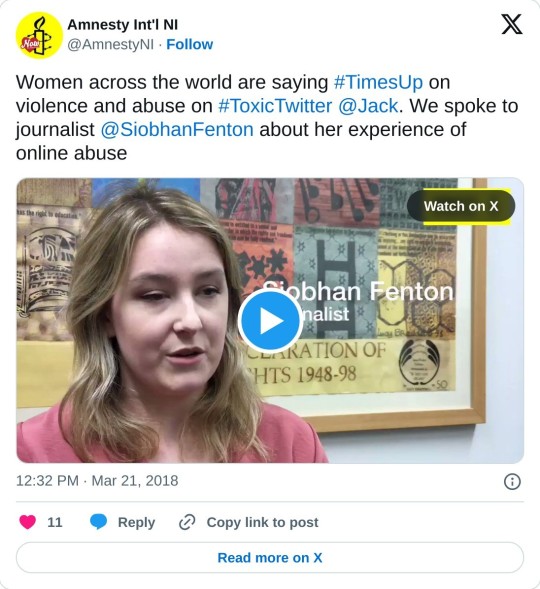

Figure 1. An anti-abortion comment from the manosphere aimed at a feminist female blogger.
Online harassment is pervasive in digital spaces, leading some young women to tolerate offensive and abusive communications (Smith, 2018). Young women perceive such communications to be relatively acceptable and the 'norm' (Haslop et al., 2021, p. 1413). They often use silencing strategies like blocking, reporting, and limiting participation, self-censorship as means of protection (Haslop et al., 2021, p. 1413). In the case of Siobhan Fenton, she silently suffered without reporting it to X because she knew this often happened to her colleagues and reporting was ineffective. Online harassment hinders women's online participation and citizenship, leading to gendered digital divides (Vitis & Gilmour, 2016, p. 337). It negatively impacts victims' motivation to use and engage with digitized spaces, leading to women excluding themselves from online spaces (Haslop et al., 2021, p. 1412).
Regarding digital citizenship, which allows internet users to participate without fear (Thompson, 2023), is threatened by online harassment (Vitis & Gilmour, 2016, p. 337). Online harassment also leads to offline violence and contributes to mental health issues, as it makes women feel unsafe in online spaces (Vitis & Gilmour, 2016, p. 337). Kelly Sue DeConnick, a comics writer, criticized sexism in the industry, highlighting the potential harm of online harassment on her family due to anxiety or fear of being blamed for speaking up (Amnesty International, 2018). Therefore, addressing online harassment is crucial for promoting digital citizenship and reducing gender disparities.

Figure 2. Kelly Sue DeConnick.
What can be done?
In Vietnam, the Law on Cyber Security provides protection against cyberbullying and harmful online content, with ministries responsible for ensuring online safety and removing inappropriate material (Vietnam Law and Legal Forum, 2023). Additionally, some women employ humor and social media platforms as a means of engaging, resisting, and responding to harassment (Vitis & Gilmour, 2016). Projects like Instagranniepants (Figure 3) and Gensler's critical witnessing utilize satire and shame, aiming to give harassers a taste of their own medicine through unflattering portraits (Vitis & Gilmour, 2016).
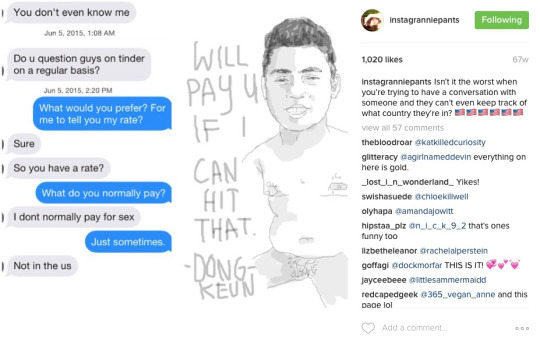
Figure 3. Instagranniepants project.
References
Amnesty International. (2018, March 20). Toxic Twitter - The Psychological Harms of Violence and Abuse Against Women Online. Amnesty International. https://www.amnesty.org/en/latest/news/2018/03/online-violence-against-women-chapter-6-6/
Haslop, C., O’Rourke, F., & Southern, R. (2021). #NoSnowflakes: The toleration of harassment and an emergent gender-related digital divide, in a UK student online culture. Convergence: The International Journal of Research into New Media Technologies, 27(5), 1418–1438. https://doi.org/10.1177/1354856521989270
Marwick, A. E., & Caplan, R. (2018). Drinking male tears: language, the manosphere, and networked harassment. Feminist Media Studies, 18(4), 543–559. https://doi.org/10.1080/14680777.2018.1450568
Thompson, J. D. (2023, March 17). New journalism research will help mitigate the harms of online hostility. Freilich Project for the Study of Bigotry. https://freilich.anu.edu.au/news-events/blog/new-journalism-research-will-help-mitigate-harms-online-hostility
Vietnam Law and Legal forum. (2023). Protection of women and juveniles from cyberspace violence in Vietnam today. Vietnamlawmagazine.vn. https://vietnamlawmagazine.vn/protection-of-women-and-juveniles-from-cyberspace-violence-in-vietnam-today-71137.html
Vitis, L., & Gilmour, F. (2016). Dick pics on blast: A woman’s resistance to online sexual harassment using humour, art and Instagram. Crime, Media, Culture: An International Journal, 13(3), 335–355. https://doi.org/10.1177/1741659016652445
#mda20009#online harassment#online abuse#protect women#Instagranniepants#manosphere#digital citizenship#safeonline
0 notes
Text
Self portraits with two songs
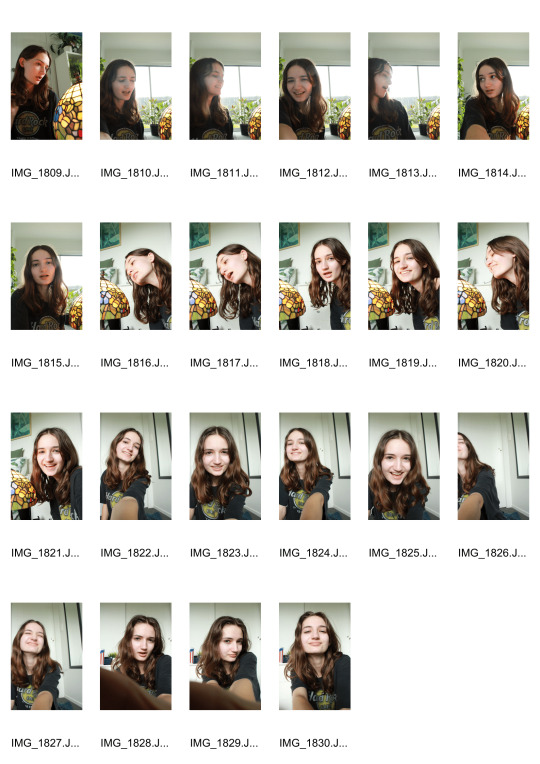
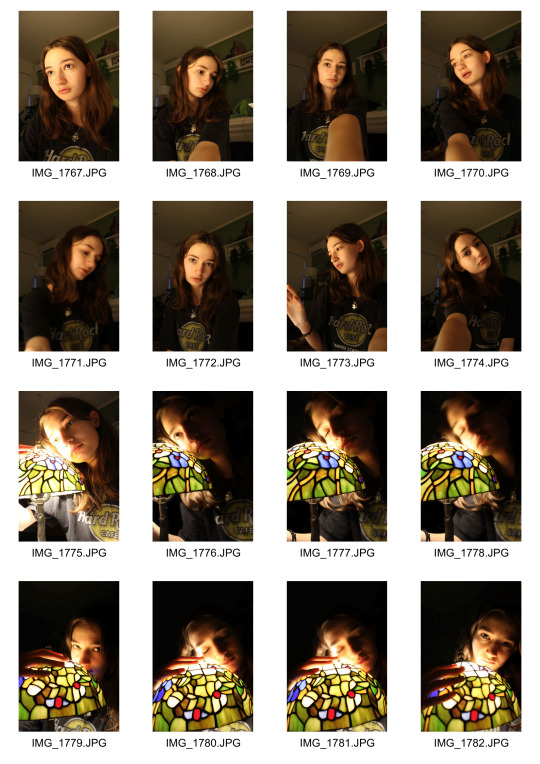
This was my first attempts at self portraits, and I'm going to be honest, I do not feel satisfied with them.
In my time of practicing photography for the past few years, I have only ever taken photos of landscapes or events. This involved me being behind the camera taking photos of other people and places.
With me now being in front of the camera, it felt very unusual to me. My camera does not have a flip screen attachment, so I felt as if I was gambling whether or not I was in the frame properly and if my manual settings were accurate. A lot of the time neither were right. This is where my knowledge of my manual settings and composition will really have to improve as I can no longer see it as I take the photo, but will have to set it beforehand.
For this shoot, I listened to two songs 'Hotel California' (Eagles) on the left and 'my future' (Billie Eilish). First, 'Hotel California' is an upbeat and catchy song that I know all of the words to. I was enjoying myself singing the lyrics and taking photos without worrying too much. With this song, I really just wanted to feel more comfortable being in front of the camera for the first time, rather than worrying about how they turned out.
Secondly, 'my future' is a very slow and solemn song that I find to be very therapeutic and peaceful. I thought that this song would work better with a darker atmosphere, rather than the daylight I used for the first shoot. If I were to make a change now, I would have used a cool toned light to create the atmosphere of sadness. I also think that a few of my shots were incorrectly exposed (with still not being used to this new process) and the light is poorly placed and comes across as unflattering.
This was a difficult shoot for me overall, as I felt out of my element and I also questioned my abilities as a photographer. I felt that these photos were 'amateurish', which they are, as I am an amateur self portrait photographer. This was hard to accept, as it felt like a step backwards. However, I will keep reminding myself that this is the journey that I need to take to improve with my skills overall.
I am looking forward to seeing how my self-portrait photography will progress over this semester.
1 note
·
View note
Text
Dorothy Thompson Is the Most Famous Female Journalist You've Never Heard Of
She made a name for herself by speaking out against fascism abroad and at home. Then the fight got personal.
— January 11, 2024 | Kirstin Butler

A Full-Color Illustration Featuring Archival Images of Journalist Dorothy Thompson, a Typewriter, Marching Nazi Troops, and the Book "I Saw Hitler". Art by Colin Mahoney. Source photo of Dorothy Thomspon: National Archives and Records Administration
On the morning of August 25, 1934, the American journalist Dorothy Thompson was taking breakfast in her room at the Hotel Adlon in Berlin when she received a letter from the Gestapo. “In view of your numerous anti-German publications in the American press,” Thompson was informed, “the German authorities, for reasons of national self respect, are unable to extend to you a further right of hospitality.”
The Reich bore her a distinct animus. For years, she had been critical of fascist movements throughout Europe. After being granted an interview with Hitler in 1931, Thompson wrote an especially unflattering portrayal of the soon-to-be German chancellor. That long essay, which first ran in Cosmopolitan Magazine, was subsequently turned into a book called I Saw Hitler. “He is formless, almost faceless,” Thompson had written, “a man whose countenance is a caricature, a man whose framework seems cartilaginous, without bones. He is inconsequent and voluble, ill-poised, insecure. He is the very prototype of the Little Man.” In addition to that injurious portrait, Thompson had produced a series of articles for the Jewish Daily Bulletin deploring Hitler’s anti-semitic policies.
The Führer was reportedly threatened enough by her work to demand the creation of a “Dorothy Thompson Emergency Squad” to rush translations of her articles. Now, at the personal directive of Hitler himself, she was being expelled from the country, an unprecedented act against an American correspondent.
A cadre of foreign journalists sent Thompson off, colleagues from her years as Central European Bureau chief for the New York Evening Post and Philadelphia Public Ledger. (She had been the first-ever woman appointed to the position, which oversaw foreign coverage for both newspapers, a decade earlier.) “Nearly the entire corps of American and British correspondents went to the railway station to see her off and wish her good luck,” the New York Times reported, adding that Thompson was presented with an armful of American Beauty roses as a gesture of admiration.
Far from silencing her, the expulsion only increased Thompson’s influence. The Times featured the story of her ban on the newspaper’s front page, and eagerly ran her reflections about it the following day. “My offense was to think that Hitler is just an ordinary man,” she wrote. “That is a crime against the reigning cult in Germany, which says Mr. Hitler is a Messiah sent by God to save the German people—an old Jewish idea.” Thompson closed her column in the Times with the kind of bon mot that had already propelled her to public renown: “To question this mystic mission is so heinous that, if you are a German, you can be sent to jail. I, fortunately, am an American, so I merely was sent to Paris. Worse things can happen to one.”

Thompson in 1937. Getty Images.
Upon her return to the United States, Thompson turned her indomitable energies toward denouncing fascism with every opportunity she was offered, and she was offered many. First came a 30-city lecture tour spanning the next year and a half. Then in 1935, NBC offered Thompson her own weekly radio show, allowing her to speak directly to tens of millions. The next year she began writing “On the Record,” a regular column with the New York Herald Tribune, that was syndicated to 150 other newspapers across the country, placing her opinions in front of millions more. She was eventually given a TIME magazine cover, where the accompanying profile called her and Eleanor Roosevelt “undoubtedly the most influential women in the U.S.”
Thompson leveraged all of these platforms to warn audiences about the dangers of totalitarianism—but not just in Europe. At home, she found cause for concern in the New Deal, with its wage- and price-setting, its massive public works projects and centralized power vested in the executive branch, all of which she feared could presage a slide into authoritarian rule. “What we are interested in is neither the dictatorial talents nor the dictatorial predilections of the President. We aren’t concerned with whether he wants too much power, but with whether he can get too much power.” In 1937, she testified before Congress about what she viewed as a slippery slope from consolidated federal control to fascism. “In country after country, under one slogan or another, the people are retreating from freedom,” Thompson told the Senate Judiciary Committee, “and voluntarily relinquishing liberty to force and authority.”
“Her point was this can happen anywhere,” University of London professor Sarah Churchwell told American Experience. “You have to strengthen your Democratic guardrails. You have to ensure that you don't let this happen to you because complacency is the enemy. And that is what she wrote about over and over and over again, banging the drum. Warning people, take this seriously. This isn’t a joke. And nobody is immune to it.” Thompson saw no conflict between her roles as a journalist and a staunch anti-fascist voice. “The function of journalism and a free press is not confined to the presentation of news,” she wrote. “Their function is to create continual debate, to provide a forum, to give opportunity for the expression of opinion.”

A promotional poster for the 1939 Bund rally in Madison Square Garden. Image courtesy of the National Museum of American Jewish Military History.
When it came to homegrown American Nazism, that expression involved significant personal risk. Thompson’s moment of direct action took place on February 20, 1939 at New York City’s Madison Square Garden. She was on her way to give a speech when she decided to join a convocation of 22,000 American Nazis hosted by the German American Bund, a pro-fascist organization with chapters across the country. The event had been planned to coincide with George Washington’s birthday, billed by the Bund as a “mass demonstration for true Americanism.”
Coverage in The Boston Globe the next day noted that the rally had “all the trappings of the spectacular mass assemblies familiar to Nazi Germany…Storm troopers strode the aisles. Military bands blared martial airs and German folk songs. Young and old Bund members paraded and drilled in the glare of blue spotlights. Arms snapped out in the Nazi salute.” The American flag hung side by side with the Nazi swastika and banners bearing messages such as “Stop Jewish Domination of Christian America.”
Thompson was seated in the front row of the press box, and during the evening’s speeches, began to laugh, loudly and disruptively. After being escorted out of the building by New York City police, she returned to her seat where she was surrounded by a dozen Bund stormtroopers. Thompson then proceeded to cause a second scene by shouting “bunk!” at the stage. “It may have been her finest moment,” wrote her biographer Peter Kurth, “the indelible dramatization of her promise to Hitler that she would not be muzzled by thugs.”
“I was amazed to see a duplicate of what I saw seven years ago in Germany,” she told a reporter after leaving the event. “Tonight I listened to words taken out of the mouth of Adolf Hitler.” It was precisely those words’ utterance at home that alarmed her most. She had spent a good part of her career watching how fascism could, improbable as it might first have seemed, sweep over a nation.
“No people ever recognize their dictator in advance,” Thompson wrote in a 1937 “On the Record” column, making the clearest case possible for constant vigilance. “He never stands for election on the platform of dictatorship. He always represents himself as the instrument for expressing the Incorporated National Will. When Americans think of dictators they always think of some foreign model. If anyone turned up here in a fur hat, boots and a grim look he would be recognized and shunned…But when our dictator turns up you can depend on it that he will be one of the boys, and he will stand for everything traditionally American.”
#Nazi Town | USA 🇺🇸#Article#NOVA | PBS#Dorothy Thompson#Most Famous#Female Journalist#Kirstin Butler#American Experience
0 notes